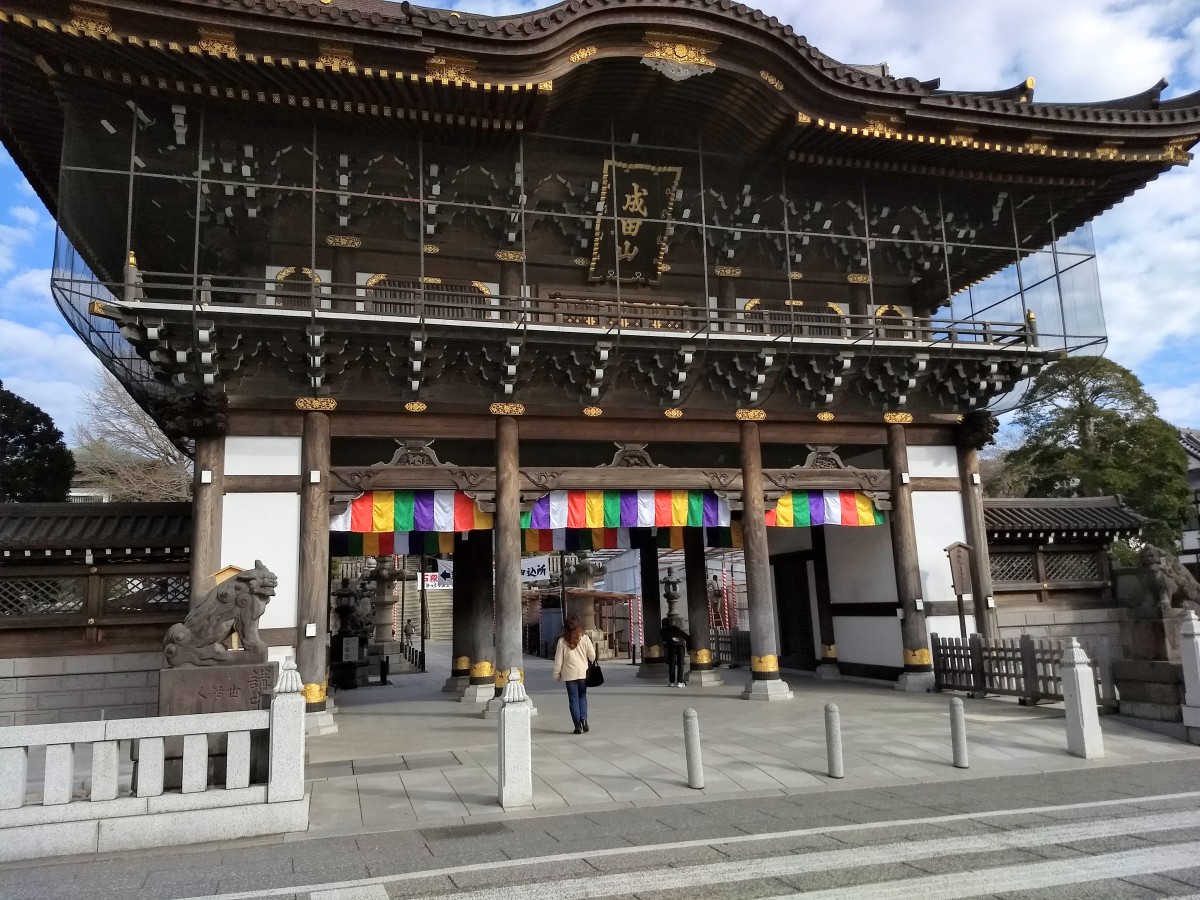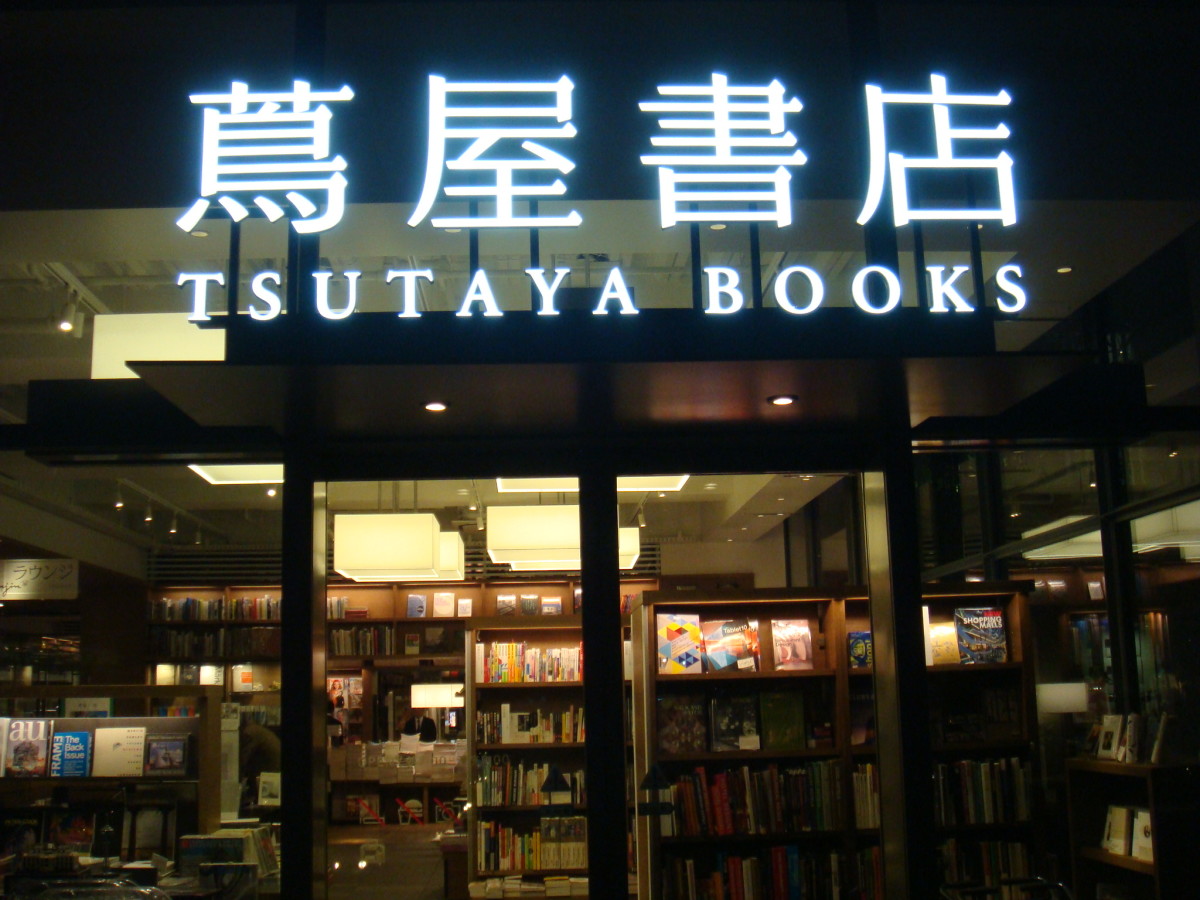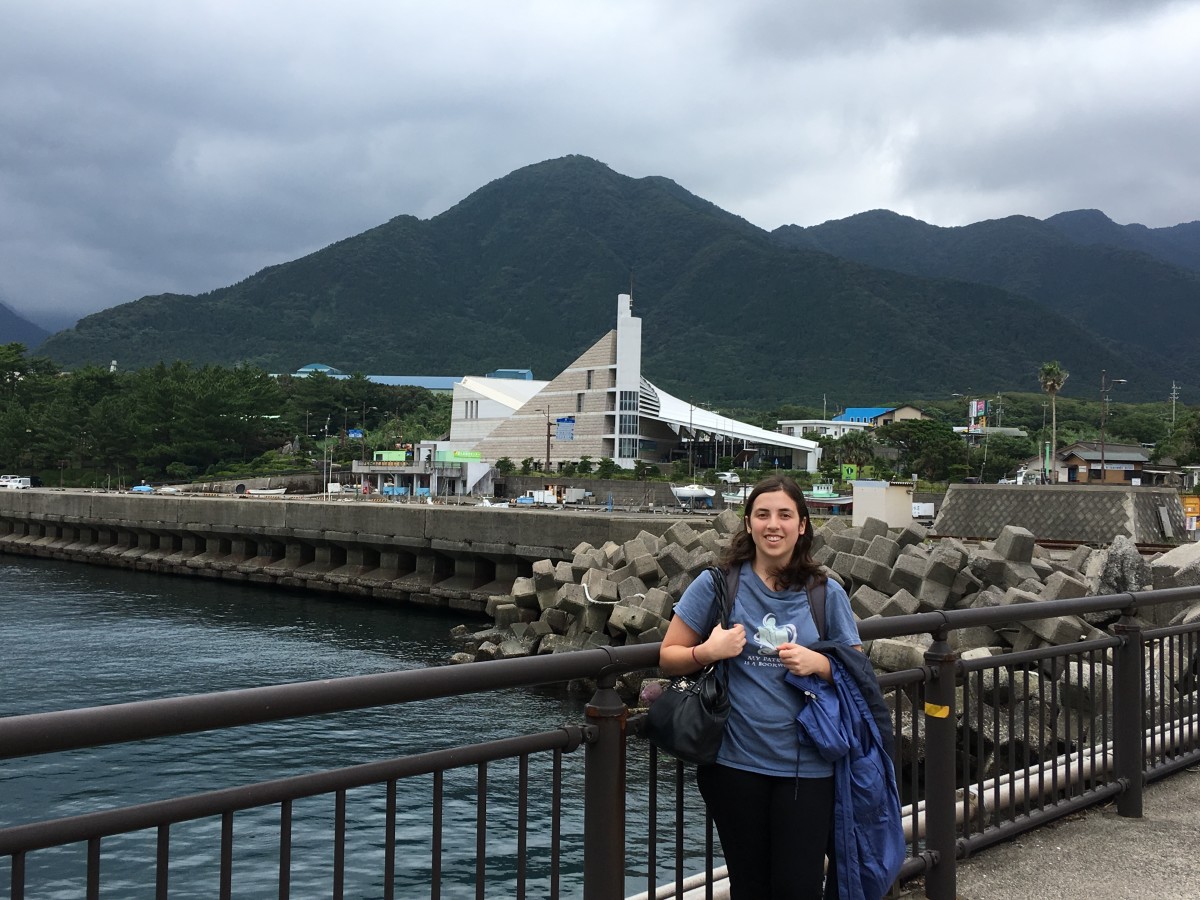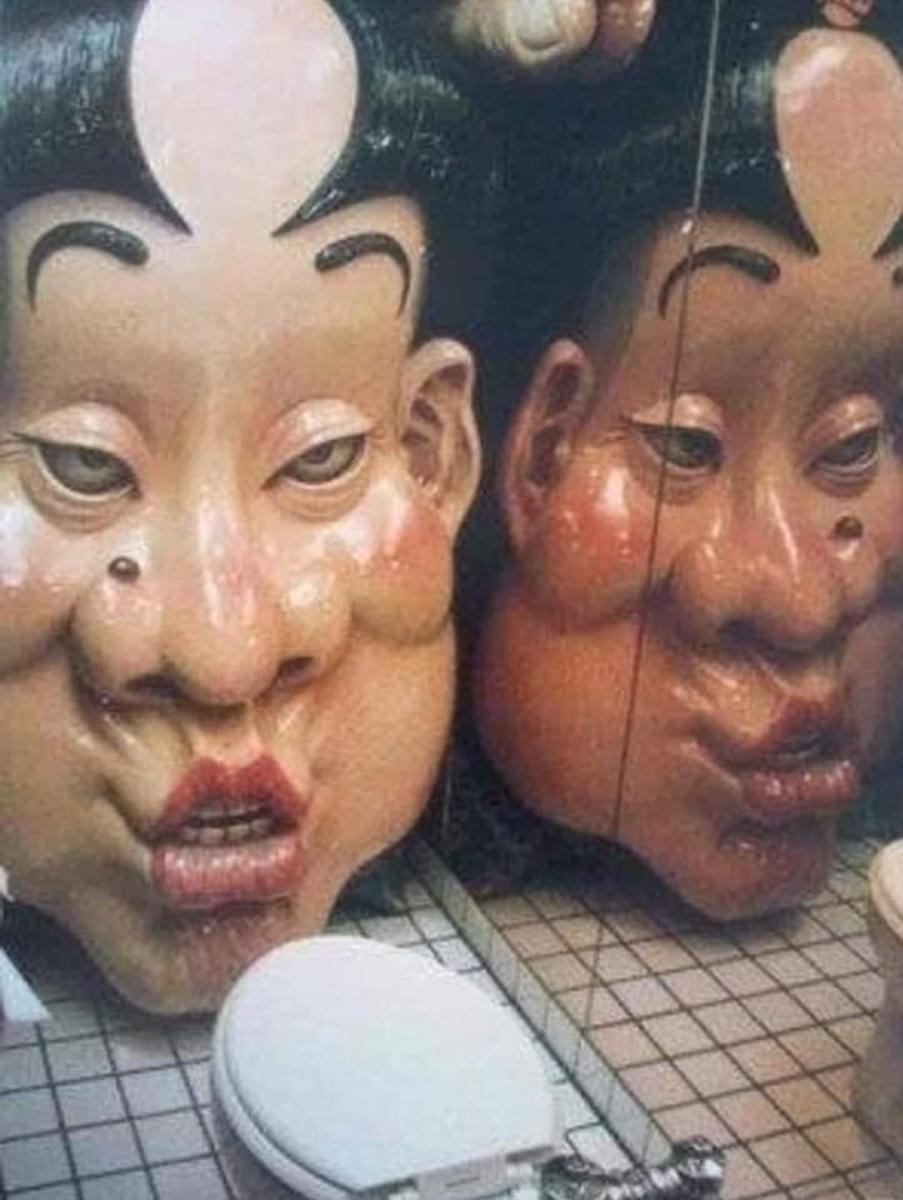- HubPages»
- Travel and Places»
- Visiting Asia»
- Eastern Asia
See the Best of Tokyo in Just One Day - A Guide For Reluctant Disney Fans
-Story and Pictures by Darryl
Intimidated By Tokyo? No Need To Be!
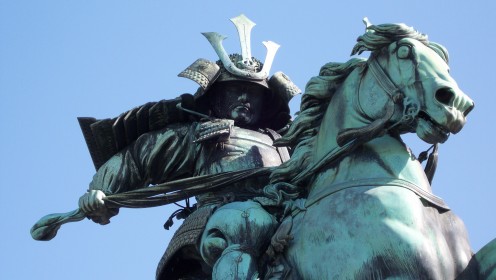
Tokyo is an inspiration, a vast and endlessly fascinating metropolis that could not possibly be fully explored in one day. Indeed, a lifetime might not suffice to explore the city's every enticement. However, there are a number of sights and cultural highlights that are not only essential, but also inexpensive (or even free!) to the curious traveler. Better still, these places are easily accessed by train or subway, and will allow even timid tourists to feel they have conquered this city as surely as any radioactive giant lizard.
I offer these suggestions most especially for those who, like myself, may have initially been drawn to Tokyo because they wanted to visit Tokyo Disneyland. In my social circle, I know a lot of people for whom Disney parks are a major part of their lives, and travel plans often (or even nearly always) center around Disney destinations. I often ask such friends, bound for Tokyo Disneyland, if they have set aside any time for Japan itself, once they have seen the theme parks. Too often, the answer is a somewhat abashed "No, we won't have enough time left. And besides, we're a little intimidated. I mean, Tokyo is so huge, and we don't speak Japanese, and we don't want to end up eating poisonous blowfish by accident, and ..." There may follow a long list of fears and anxieties, along with a kind of lip service regret that they will be missing what must be a terrific cultural experience before changing the subject.
I am here to help. The good news is, if you set aside even one day for Tokyo, you will find rich rewards, and most likely, you will leave with a determination to one day come back and devote even more time to this utterly unique, lively and unforgettable city. Better yet, you will spend a small fraction of what you would have spent on another day in a Disney park or resort, and you will have experiences that you will find yourself talking about for many years to come. Whatever you do, don't cheat yourself out of Tokyo. Now, let's get on to my own personally tested, jam-packed one-day Tokyo super-tour!
Shimbashi Station
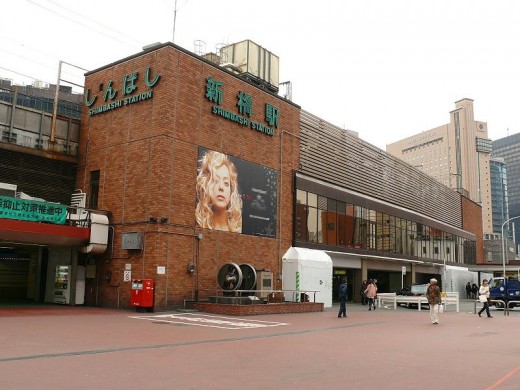
My goal on this day-long jaunt is to get you to a couple of Tokyo's largest and most significant cultural sites, Senso-Ji temple and the Meiji shrine. But we're going to take our sweet time on the way to these two landmark locations. First step is to get you to Shimbashi Station.
(If, when you saw the phrase "Shimbashi Station," you immediately made a joke about looking at power converters, you are my kind of reader!)
Now, my target readership are staying on or near the Disney resort, so, here's your route. From Maihama station, take the Keiyo line to Tokyo Station. (It's six stops away: Maihama - Kasairinkai Koen - Shin Kiba - Shiomi - Etchujima - Hatchobori - Tokyo) Transfer to the Yamanote Line and proceed to Shimbashi Station, just two stops away. (Tokyo - Yurakucho - Shimbashi). The most complicated part of your day is over.
For just about anyone else, no matter where you may be staying, Shimbashi Station is on the Yamanote line, which makes a giant loop around the greater Tokyo area. Once you have found your way to a Yamanote line station, Tokyo is at your command. I'll say more about this later, but for now, figure out how to get from your accommodations to Shimbashi Station on the morning of your Tokyo venture.
How early should I get there?
That's entirely up to you. I'd recommend as early a start as you can comfortably manage. It will really pay off if you can start this journey somewhere between 9am and 10am. After 10, your day really starts to burn away quickly, and getting an early start will put you so far ahead of the game, you will really be able to relax and enjoy what, on paper, looks like a pretty aggressive itinerary.
For the True Early Birds
Okay, if you are really motivated, and you arrive bright and early, you may want to venture to Tsukiji Fish Market. It's the largest, busiest fish market in the world. If you are here before 8am, you may even get to witness the loud, boisterous fish auctions. I've talked to people for whom this was the highlight of their trip. In all honesty, I wouldn't know. I didn't get here nearly that early, and only walked along the outskirts of the market. But, I did sample some very fresh sushi (which makes a nifty breakfast) at a small stand near the market. So, regard Tsukiji as an option for you high energy types, and if you make it here, send me a photo or two of your experience.
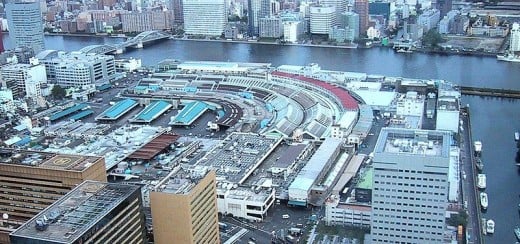
Hama-Rikyu Garden - Our First Stop
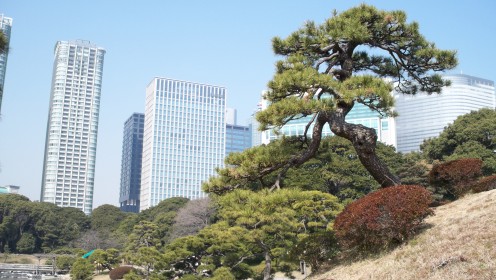
We begin our journey proper here in one of Japan's largest traditional gardens. Hama-Rikyu (which means “detached palace”) was originally the private fortress of the Tokugawa shogunate. Nobles used this as their private duck hunting preserve, and later, it became an off-limits get-away for the Emperor and Empress. In 1942, the land was opened up to the public, and now, it's a peaceful and pretty green oasis surrounded by gleaming skyscrapers.
Your entry into the gardens will cost you a nominal 320 yen. (That's a little over 3 bucks in American simoleans.) If you look as non-Japanese as me, you will most likely be handed an English-language guide book without having to ask for it.
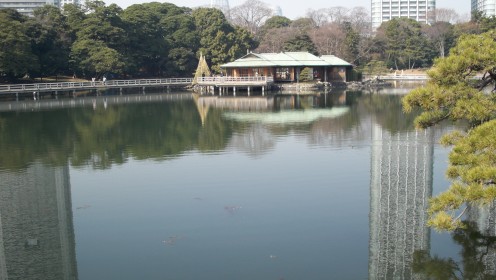
The most famous spot in this park is the large tidal pond, which is filled with salt water from adjoining Tokyo Bay. Across a long wooden bridge, you'll find a traditional tea house. If you wish, you can partake of a ceremonial green tea service, which includes some traditional Japanese sweets. It's only 500 yen, (around 5 bucks) and a terrific old school experience.
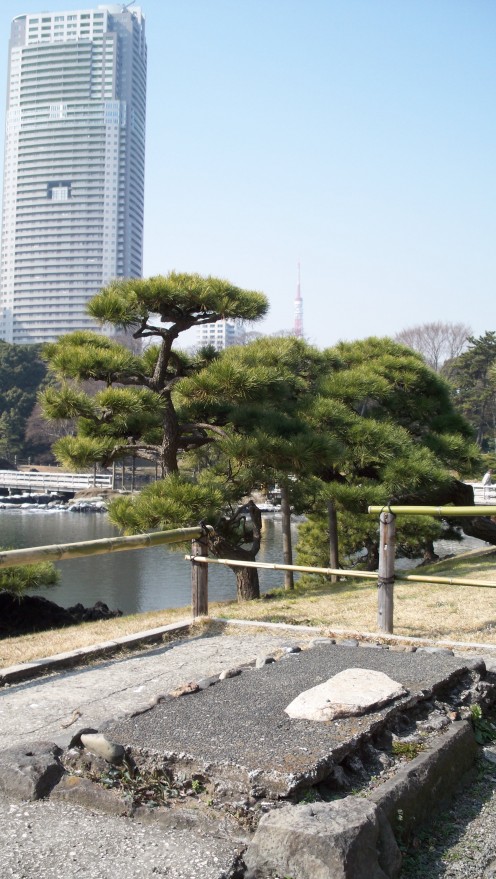
The original tea house stood on this spot, but was burned down during the fire raids of World War II. This foundation is all that remains. (Reminders of the near-total immolation of Tokyo are found at nearly every historical site. Most temples and shrines have been completely rebuilt in the years following the war.)
The grounds here are pretty extensive, and you can easily spend an hour or so wandering among the trees and following paths into hidden groves where small canals once served as branch-shrouded duck blinds. There is a small shrine dedicated to the spirits of all of the birds who were hunted here over the centuries. It's perfectly safe to be a duck here these days, and you will probably see a few, along with numerous other bird species. (Occasionally, there are even falconry demonstrations.) If you happen to arrive during cherry blossom season, you will find over 100 cherry trees here, bursting with ephemeral pink and white blooms. Floral displays change throughout the year to reflect the seasons.
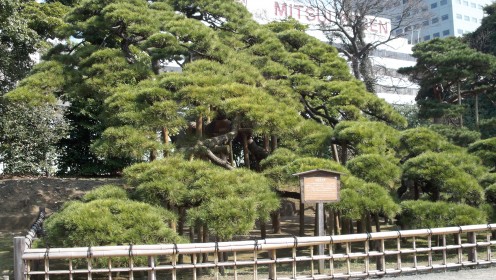
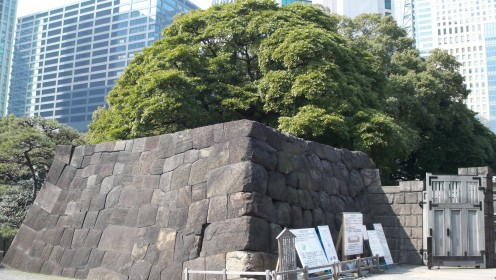

As you leave the gardens, see if you can spot this curious building, the Nakagin Capsule Tower. Each of these modular apartment units was assembled off-site and slid into place, purportedly making upgrades as simple as changing out modules. My fellow Disneyphiles will notice a conceptual similarity with Disney’s Contemporary Resort. The concept never really panned out, and many have compared this building to a stack of used washing machines. (Note – I’ve read that age and asbestos issues have condemned Nakagin to demolition in the near future, so by the time you visit, this tower may be history.)
Next Up - Sumida River Cruise
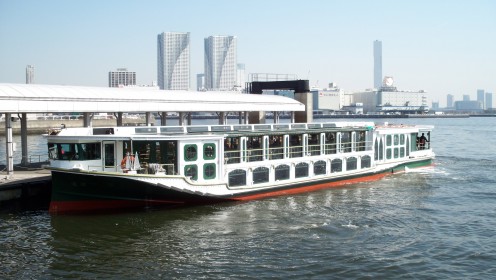
The next stage of our journey starts at the boat dock located right here on Tokyo Bay, next to the gardens. We are going to take the Sumida River Cruise to Asakusa. This is going to cost about 750 yen, and will take around 35 to 40 minutes. Now, this isn't a ride along green, tree-lined riverbanks. This boat passes through the very heart of the city, and you can practically feel Tokyo busily hustle and pulse on both sides of the waterway. The journey passes by the very modern Rainbow Bridge to Odaiba, and then glides along beneath 12 different bridges as it heads roughly north. Each bridge has a different name and a different design, and a pre-recorded spiel, delivered in Japanese and English, will tell you about each one.
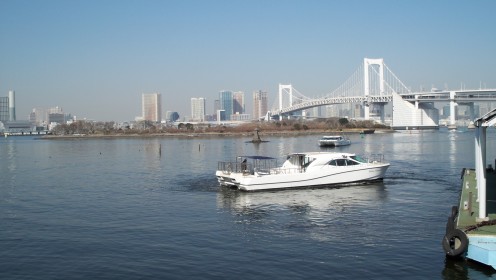
If you have spent the last 20 years of your life in a relatively small city like Orlando (as I have), then it is difficult to wrap the mind around the scope of industry and activity visible from these shores. Startling examples of modern architecture are all around.
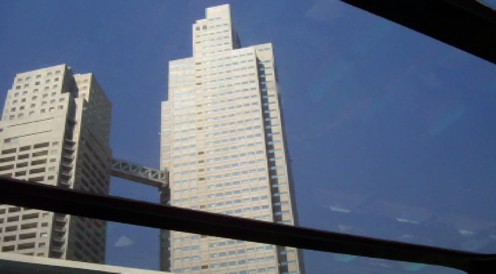
Perhaps the most notorious is coming up on your right. This is the Asahi Beer Hall. That giant sculptural element, designed by Phillipe Starck, is called The Golden Flame, and is presumably intended to be inspiring and impressive. Built in 1989, it immediately met with resistance from the Tokyo populace, who often refer to it as “kin no uchi,” the golden turd. Once you’ve heard this appellation, it's hard to see it as anything else.
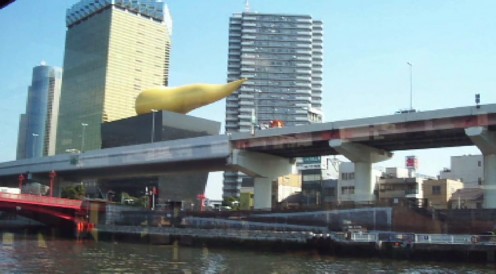
Just across from the Asahi building is our boat dock. It's time to disembark and step into the Shitamachi, the old city.
Asakusa
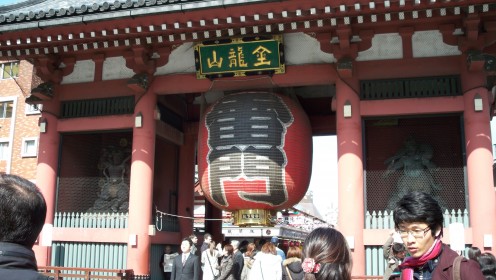
Just a short block away from the boat dock, you will find yourself face to face with Kaminarimon – the Thunder Gate. That’s a giant paper lantern hanging in the center of it, and to either side are some formidable looking statues. These are Raijin, the god of thunder, and Fujin, the god of wind. You are entering the Senso-ji temple complex, a fantastic destination at any time of year. (And best of all, no charge whatsoever to visit.)
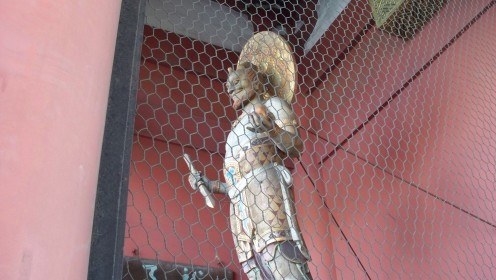
Before you get to the temple, you must pass through Nakamise-dori, a half mile row of shops selling traditional crafts, trinkets, foods and clothing. Many of the tiny little boutiques have been run by the same families for generations. It’s a good spot for treasure hunting, if you don’t mind being very touristy. Better quality and greater bargains are likely to be found in the surrounding neighborhood, but this street is nothing if not convenient. Think of it as Japan’s answer to Portobello Road.
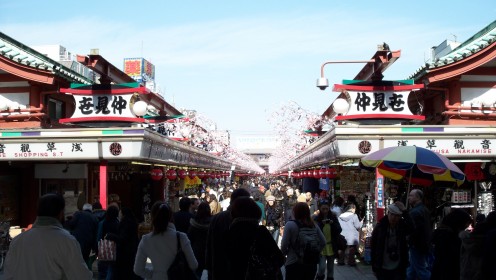
Even if you don't decide to buy anything, Nakamise provides a perfect opportunity to try a few traditional snacks. I had a fresh hot rice cracker (called senbei) and a gooey round of mochi rice cake. You'll find any number of meats-on-a-stick as well. everything was reasonably priced.
Asakusa is a very old part of Tokyo, and back in feudal times, it wasn’t exactly the high-class part of town. Gambling, prostitution, (and perhaps most scandalous of all, kabuki theater!) were all the rage in this pleasure district. Now, it’s a place of narrow streets, family-run shops, and giant festival processions. (If you arrive in early May, you might find yourself jostling with a couple million Japanese celebrating Sanja matsuri, a colorful parade of portable shrines.)
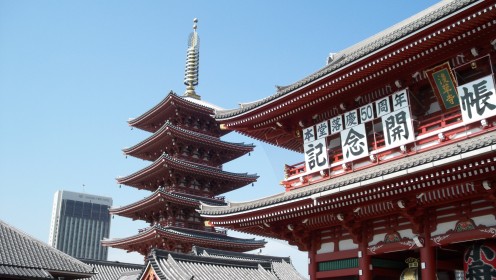
The Buddhist temple complex at Senso-ji shares in the high spirits of its surroundings. Scarcely a solemn place, it seems to engender an upbeat and energetic vibe. Beyond Nakamise-dori, you face a second gate, Houzoumon.
Once you pass through, be sure to look back at the gigantic “sandals of the gods.” This straw-woven footwear is replaced every fifteen years. The pair in this picture was on its “last legs” so to speak in February of 2008, removed just days after my visit.
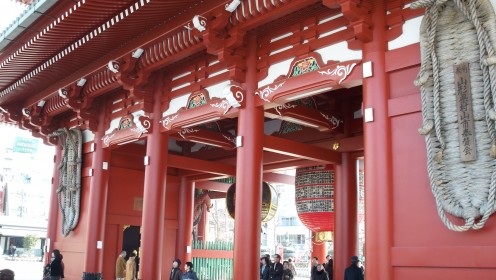
Kannon-do is the heart of the shrine, built to house a statue of Kannon, a many-armed deity of mercy whose statue was fished out of the nearby Sumida river by a couple of young fishermen many centuries ago. No, they won’t show you the statue, which of course causes skeptics like me to wonder if there is any such relic any longer present. (I hope so!)

Gojunotou - The five-story pagoda is said to house ashes of the Buddha. Like every other structure here, it was rebuilt in the decades following World War II, though the very top of the original pagoda rests nearby on a pedestal, looking quite nice.

Throughout the area, there is a constant metallic rattling noise from people shaking little bamboo sticks out of metal canisters. Each stick has a symbol corresponding with a fortune located in a little drawer. Shake out a stick and match up the symbol to find your fortune.
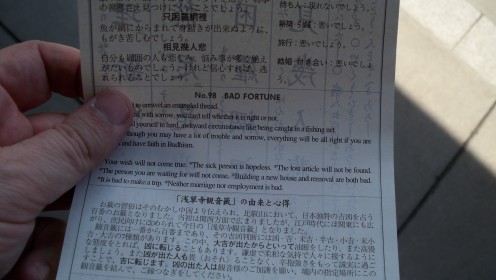
I got a WARUI (bad!) fortune! Luckily, there is a way around this. Fold the paper and tie it onto a little wire rack, and you can leave the bad fortune behind you. (Likewise, if it’s a good fortune, you can still tie it up. I’m not entirely sure how that’s supposed to work.)
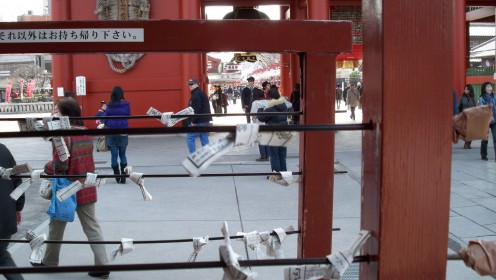
The smell of sweet incense is everywhere, and you will find visitors wafting the smoke over their heads, bodies, pocketbooks and so on – hoping to improve their health, good fortune and even test scores.
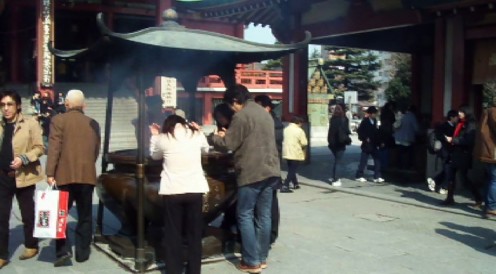
There are plenty of small discoveries to be made on the grounds. I particularly enjoyed this small shrine, dedicated to Kume Heinai, an Edo era warrior who ruthlessly killed hundreds in battle, but then repented and asked that his body be buried in a busy public place so that it would be trampled over. After a few centuries, it was decided that he had paid his penance, and his modest memorial now sits in a nice shady place. It was one of many spots where I found themes of redemption and the long, slow struggle for a peaceful world.
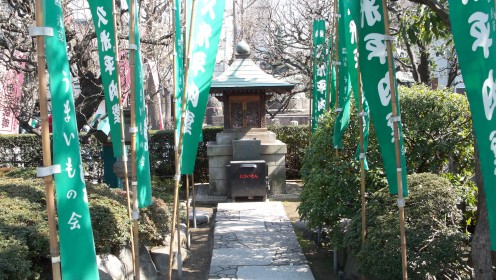
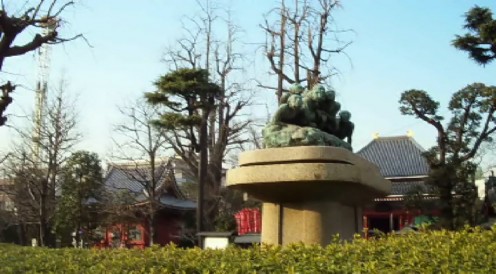
There are lots of stories told by the monuments and markers here. As much as I’m tempted to share each of them here, it’s better if you make your own discoveries. (Of course, I just may add another hub someday!)
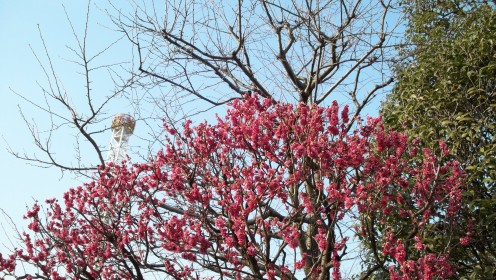
Early cherry blossoms in February – and in the distance, the Bee Tower, an attraction at the very tiny, very old theme park Hanayashiki. I’ve run across other sites calling this park hokey, lackluster and worn out. All those words just may fit, but I’ve got a real soft spot for the place. It may or may not warrant your time, though, so I’m going to give it a separate hub for those who are interested.
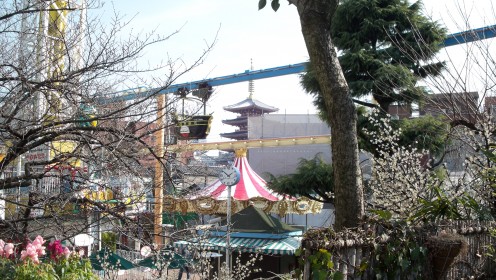
A Senso-ji Visit
It's Time To Travel to Harajuku
Okay, this next patch of text is a little dry, but it's important. We have a long (not really TOO long) trip to make by subway and train. We are going to cross clear to the other side of Tokyo to visit the Meiji shrine in Harajuku. By now, it’s probably one or two in the afternoon.Take a break and grab a bite to eat. Then walk back toward the boat dock. Just to the left of it, you will see Asakusa station. Look for the Ginza subway line.
We are going to take the Ginza line over two stops – from Asakusa, to Tawaramachi and then to Ueno station. Disembark at Ueno station and head to the Japan Railways Yamanote line. (By the way, if it is cherry blossom season, make a note of Ueno station. This is your stop if you decide to go to Ueno Park. It’s THE spot for hanami, cherry blossom viewing. I haven’t had the pleasure, but I’m told that there are massive throngs of people and the atmosphere is rowdy. Beer, portable karaoke and the odd flying underwear, from what I’ve heard. If this sounds like your cup of green tea, well, remember, Ueno station – Ueno Park!)
Ah, back to the Yamanote line! As I’ve mentioned already, once you master the Yamanote, you own the vastness of Tokyo. Now, the Yamanote makes a great big loop, so worst case scenario, if you miss your stop, you will end up there again sooner or later. Our goal is Harajuku Station, and it’s on almost the exact opposite side of the loop. If you take the clockwise train, you are fifteen stops away from Harajuku. If you take the counter-clockwise route, you are fourteen stops away. Either way, it goes by pretty quickly. Trains in Japan are famously efficient, and they don’t hang out in the station for very long. (Be prompt when boarding. And avoid morning and afternoon rush hour! You may end up being jammed like a sardine into a compartment by white-gloved “pushers.” Happily, if it’s around 2pm by now, you are golden.)
Just to put you at ease, here is a listing of all the stations you will pass through. (And just think, you are really and truly going deep into Tokyo. You are the very picture of the worldly traveler!)
Clockwise: Ueno – Okachimachi – Akihabara – Kanda – Tokyo – Yurakucho – Shinbashi – Hamamatsucho – Tamachi – Shinagawa – Osaki – Gotanda – Meguro – Ebisu – HARAJUKU!
Counter-clockwise: Ueno – Uguisudari – Nippori – Nishi Nippori – Tabata – Komagome – Sugamo – Otsuka – Ikebukuro – Mejiro – Takadanobaba – Shin Okubo – Shinjuku – Yoyogi – HARAJUKU!
And here is the best news of all – in Tokyo, nearly all station signs are rendered in Japanese AND roman characters, so you will have no problem reading them. (There is even a prerecorded voice that announces each stop on board the train. You’ll do fine.)
Meiji Shrine at Harajuku
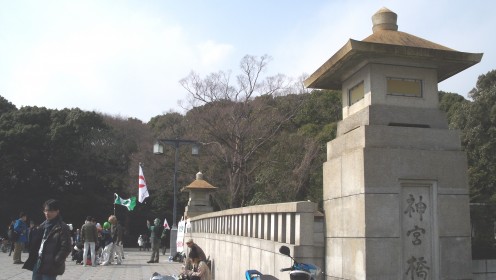
All right, we’ve reached Harajuku – a youthful and exuberant center of trendy fashion, and also home to the evergreen forests of Meiji shrine. As you emerge from the station, you will easily see the trees and wide walking lanes of Yoyogi park across the street. Safely make your way over.
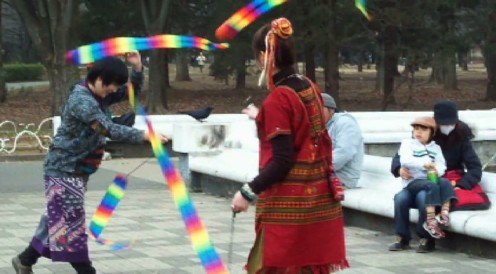
This is one of the best places for people-watching on the planet. If you are here on a Sunday, you will encounter groups of Tokyo teenagers dressed in elaborate, outrageous costumes. This is cosplay, costume play, the art of self-expression by way of garish dress, often inspired by favorite anime and manga characters. (If you’ve been to an American comics or sci-fi convention recently, then you know that this trend has caught on in the United States as well.) On the Saturday visit when I took these pictures, I found pop bands, political protesters, ribbon dancers and drummers, but only a small handful of cosplay-ers.
A tree-lined path leads the way to the wooden Tori gate of Meiji-jingu, a Shinto shrine dedicated to the Emperor Meiji and the Empress Shouken.
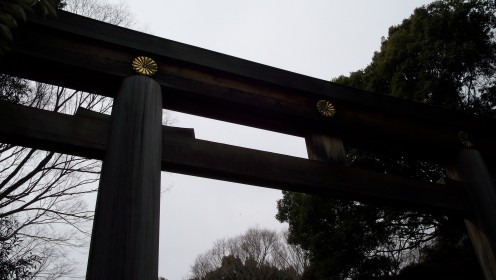
The Meiji era was a time of rapid growth and change, as Japan left behind its ancient feudal society, embraced the industrial revolution, and rose quickly to the rank of world power. However bitter and harrowing the process, ultra-modern Japan owes much of its identity to Meiji and his embrace of progress and technological prowess.
For all that, the shrine is a calm, green and peaceful place, one in which the massive surrounding city disappears, and visitors are allowed moments of reflection and the contemplation of nature.
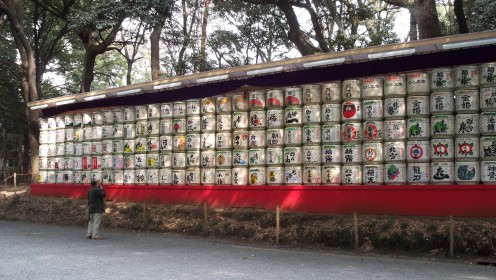
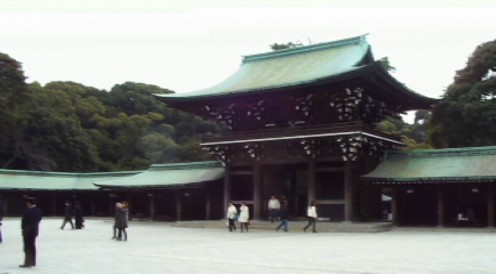
I took some time to wash my hands in the very cold waters of the purification fountain, and then paid my respects to the Emperor and Empress. Traditionally, visitors make a donation, clap their hands to get the attention of the spirits, pray or stand silently, and then bow. As rituals go, it’s very simple and pleasant, a worthwhile experience even for staunchly secular folk such as I.
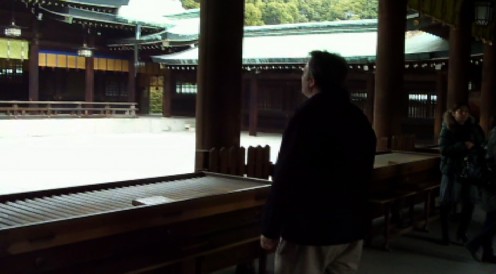
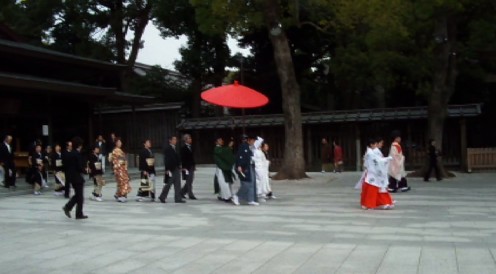
I was lucky enough to see a couple of Shinto wedding processions on my visit. This is a very popular spot for weddings, and parties are generally happy to be photographed or taped during the procession through the Gaien, or outer precinct of the temple. (Don’t follow them further into the inner Naien, though.)
Meiji Shrine
Time to Go Shopping
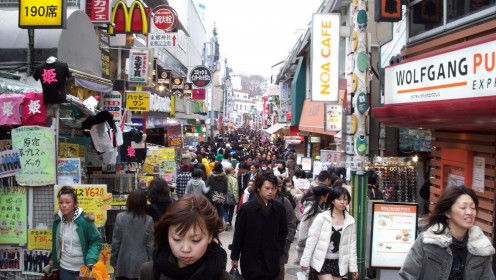
Once you have enjoyed the tranquility of the shrine, you may be ready for some shopping, and you are in one of the most unique places in the world to do just that. Head back toward the train station, and find takeshita-dori. It’s very close-by and you’ll have a hard time missing it. This is a pedestrian-only street, usually packed with eager shoppers. Many of the stores here are “antenna” shops, where designers test out their newest (and sometimes strangest) fashions on an eager young clientele. You’re sure to find things here you would never see elsewhere.
For me, well, I have to keep it thrifty – which is why I love Daiso, the 100 yen store! This is like a 5-story Dollar super-store. It’s located on the left as you head up Takeshita-dori, just past McDonalds. I hope when my friends read this article, they won’t mind when I admit that I did about 80 percent of my gift shopping there.
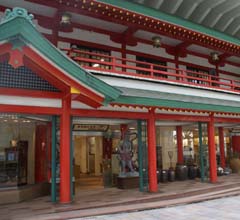
There are two more shops I want to recommend. Running parallel to Takeshita is Omotesando. (This street has actual vehicle traffic.)
If you’re still looking for traditional Japanese crafts, kimonos and so on, don’t miss Oriental Bazaar, a warehouse of discount treasures. I did the other 20 percent of my gift shopping here.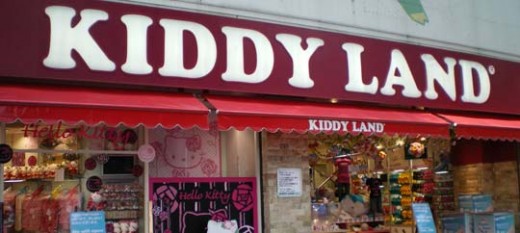
Just down the street, you will find Kiddy Land, a densely packed five story toy emporium.
If I had the time, money and space, I’d give all of these adorable kaiju monsters a home!
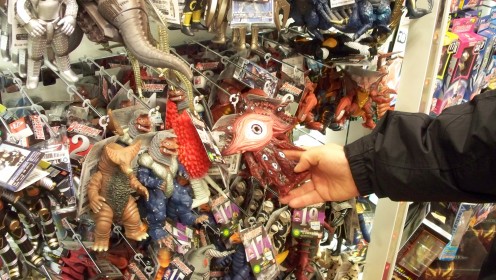
All right – we’ve gone from the gleaming, sterile skyscrapers of Shiodome, to the tatty and musty old city, to the hip and trendy heart of modern Tokyo, all in one day, and it is probably only just evening. But you must be exhausted. Find a nice place to enjoy a good meal and then make your way back to Shimbashi via the Yamanote line. (Already, you probably feel like you can get anywhere you need to go, and you can!) If you are actually ready for more (I wouldn’t be!) you can enjoy the bright neon lights of Ginza within a short distance of Shimbashi station. You may have it in you to keep exploring. I’m going back to my hotel, but thank you for spending this energetic (but somehow introspective) journey through just a little bit of Tokyo.
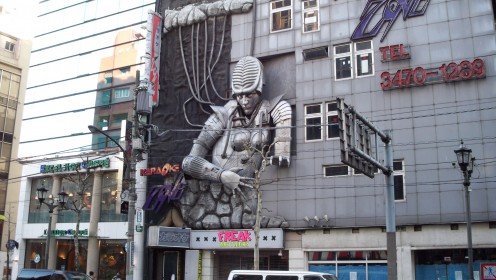
Check out another little bit of Japan in my next hub!
A Day Trip to Kamakura
- A Brief Day Trip To Kamakura - An Enticement For Disney and Tokyo Travelers
Now that you've seen some of the best of Tokyo, I highly recommend a day trip to charming, historic Kamakura, just an hour away by train, but a world away from the frantic pace of Tokyo.

